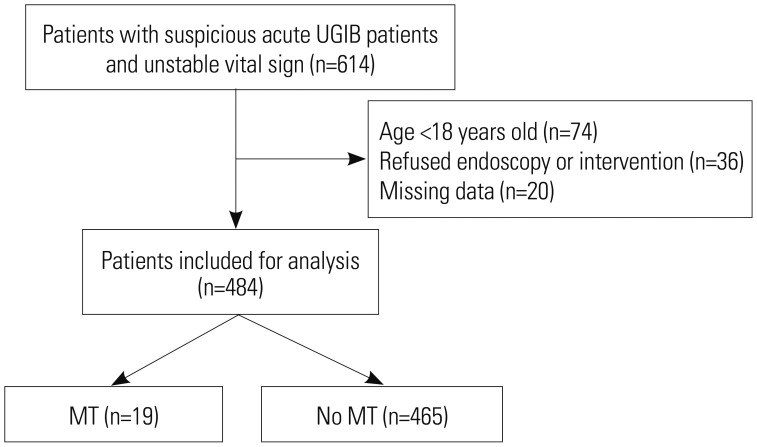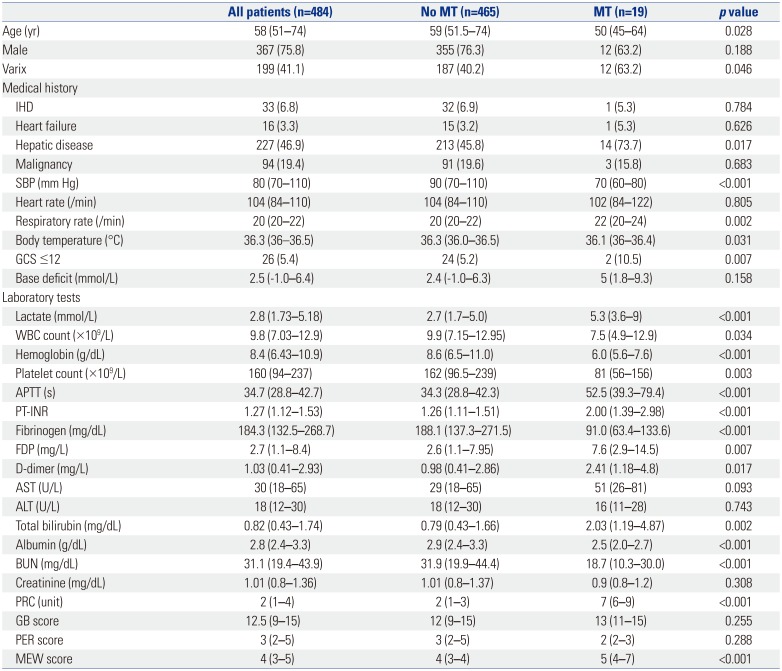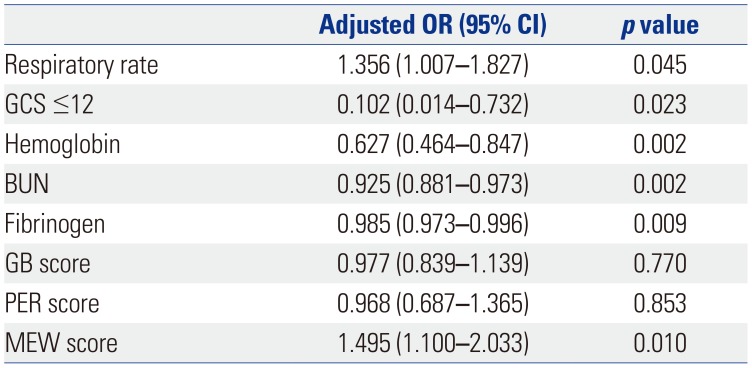1. Abd Elrazek AE, Mahfouz H, Elazeem KA, Fakhry M, Elrazek EA, Foad M, et al. The value of U/S to determine priority for upper gastrointestinal endoscopy in emergency room. Medicine (Baltimore). 2015; 94:e2241. PMID:
26656368.

2. Sanders DS, Perry MJ, Jones SG, McFarlane E, Johnson AG, Gleeson DC, et al. Effectiveness of an upper-gastrointestinal haemorrhage unit: a prospective analysis of 900 consecutive cases using the Rockall score as a method of risk standardisation. Eur J Gastroenterol Hepatol. 2004; 16:487–494. PMID:
15097042.
3. Kumar NL, Travis AC, Saltzman JR. Initial management and timing of endoscopy in nonvariceal upper GI bleeding. Gastrointest Endosc. 2016; 84:10–17. PMID:
26944336.
4. Srygley FD, Gerardo CJ, Tran T, Fisher DA. Does this patient have a severe upper gastrointestinal bleed? JAMA. 2012; 307:1072–1079. PMID:
22416103.

5. Halmin M, Chiesa F, Vasan SK, Wikman A, Norda R, Rostgaard K, et al. Epidemiology of massive transfusion: a binational study from Sweden and Denmark. Crit Care Med. 2016; 44:468–477. PMID:
26901542.
6. Fleischer D. Etiology and prevalence of severe persistent upper gastrointestinal bleeding. Gastroenterology. 1983; 84:538–543. PMID:
6600435.

7. Anchu AC, Mohsina S, Sureshkumar S, Mahalakshmy T, Kate V. External validation of scoring systems in risk stratification of upper gastrointestinal bleeding. Indian J Gastroenterol. 2017; 36:105–112. PMID:
28393330.

8. Blatchford O, Murray WR, Blatchford M. A risk score to predict need for treatment for upper-gastrointestinal haemorrhage. Lancet. 2000; 356:1318–1321. PMID:
11073021.

9. Rockall TA, Logan RF, Devlin HB, Northfield TC. Risk assessment after acute upper gastrointestinal haemorrhage. Gut. 1996; 38:316–321. PMID:
8675081.

10. Ko IG, Kim SE, Chang BS, Kwak MS, Yoon JY, Cha JM, et al. Evaluation of scoring systems without endoscopic findings for predicting outcomes in patients with upper gastrointestinal bleeding. BMC Gastroenterol. 2017; 17:159. PMID:
29233096.

11. Subbe CP, Kruger M, Rutherford P, Gemmel L. Validation of a modified Early Warning Score in medical admissions. QJM. 2001; 94:521–526. PMID:
11588210.

12. Bozkurt S, Köse A, Arslan ED, Erdoğan S, Üçbilek E, Çevik İ, et al. Validity of modified early warning, Glasgow Blatchford, and preendoscopic Rockall scores in predicting prognosis of patients presenting to emergency department with upper gastrointestinal bleeding. Scand J Trauma Resusc Emerg Med. 2015; 23:109. PMID:
26714636.

13. Lee JR, Choi HR. [Validation of a modified early warning score to predict ICU transfer for patients with severe sepsis or septic shock on general wards]. J Korean Acad Nurs. 2014; 44:219–227. PMID:
24859127.

14. Mitra B, Cameron PA, Gruen RL, Mori A, Fitzgerald M, Street A. The definition of massive transfusion in trauma: a critical variable in examining evidence for resuscitation. Eur J Emerg Med. 2011; 18:137–142. PMID:
21164344.
15. American College of Surgeons Committee on Trauma. Advanced trauma life support. 10th ed. Chicago: American College of Surgeons;2018.
16. Raymer JM, Flynn LM, Martin RF. Massive transfusion of blood in the surgical patient. Surg Clin North Am. 2012; 92:221–234. PMID:
22414409.

17. DeLong ER, DeLong DM, Clarke-Pearson DL. Comparing the areas under two or more correlated receiver operating characteristic curves: a nonparametric approach. Biometrics. 1988; 44:837–845. PMID:
3203132.

18. Straube S, Tramèr MR, Moore RA, Derry S, McQuay HJ. Mortality with upper gastrointestinal bleeding and perforation: effects of time and NSAID use. BMC Gastroenterol. 2009; 9:41. PMID:
19500343.

19. Turan A, Yang D, Bonilla A, Shiba A, Sessler DI, Saager L, et al. Morbidity and mortality after massive transfusion in patients undergoing non-cardiac surgery. Can J Anaesth. 2013; 60:761–770. PMID:
23609882.

20. Borgman MA, Spinella PC, Perkins JG, Grathwohl KW, Repine T, Beekley AC, et al. The ratio of blood products transfused affects mortality in patients receiving massive transfusions at a combat support hospital. J Trauma. 2007; 63:805–813. PMID:
18090009.

21. Kumar NL, Claggett BL, Cohen AJ, Nayor J, Saltzman JR. Association between an increase in blood urea nitrogen at 24 hours and worse outcomes in acute nonvariceal upper GI bleeding. Gastrointest Endosc. 2017; 86:1022–1027. PMID:
28377105.
22. Al-Naamani K, Alzadjali N, Barkun AN, Fallone CA. Does blood urea nitrogen level predict severity and high-risk endoscopic lesions in patients with nonvariceal upper gastrointestinal bleeding? Can J Gastroenterol. 2008; 22:399–403. PMID:
18414716.

23. Hayakawa M, Gando S, Ono Y, Wada T, Yanagida Y, Sawamura A. Fibrinogen level deteriorates before other routine coagulation parameters and massive transfusion in the early phase of severe trauma: a retrospective observational study. Semin Thromb Hemost. 2015; 41:35–42. PMID:
25590522.

24. McQuilten ZK, Wood EM, Bailey M, Cameron PA, Cooper DJ. Fibrinogen is an independent predictor of mortality in major trauma patients: a five-year statewide cohort study. Injury. 2017; 48:1074–1081. PMID:
28190583.

25. Kruisselbrink R, Kwizera A, Crowther M, Fox-Robichaud A, O'Shea T, Nakibuuka J, et al. Modified Early Warning Score (MEWS) identifies critical illness among ward patients in a resource restricted setting in Kampala, Uganda: a prospective observational study. PLoS One. 2016; 11:e0151408. PMID:
26986466.

26. Subbe CP, Davies RG, Williams E, Rutherford P, Gemmell L. Effect of introducing the Modified Early Warning score on clinical outcomes, cardio-pulmonary arrests and intensive care utilisation in acute medical admissions. Anaesthesia. 2003; 58:797–802. PMID:
12859475.

27. Kim YD. Management of acute variceal bleeding. Clin Endosc. 2014; 47:308–314. PMID:
25133116.












 PDF
PDF ePub
ePub Citation
Citation Print
Print



 XML Download
XML Download